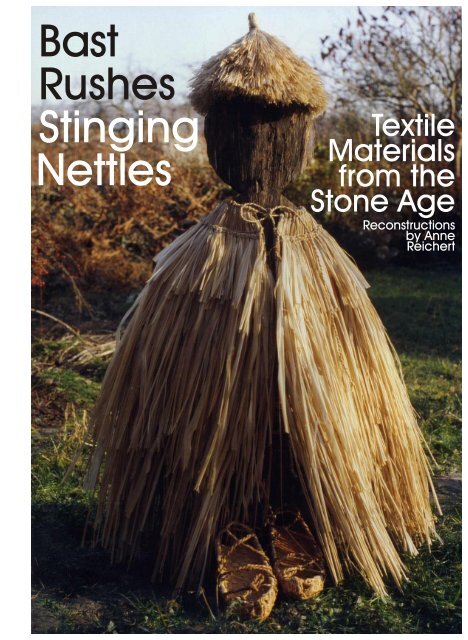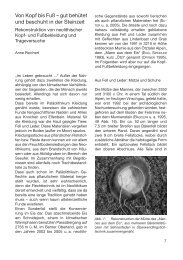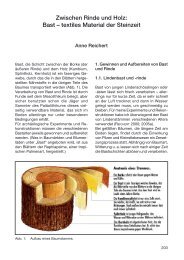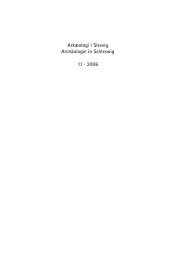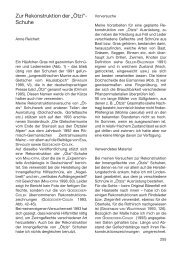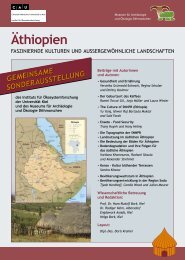Reconstructions by Anne Reichert
Reconstructions by Anne Reichert
Reconstructions by Anne Reichert
Create successful ePaper yourself
Turn your PDF publications into a flip-book with our unique Google optimized e-Paper software.
Bast<br />
Rushes<br />
Stinging<br />
Nettles<br />
Textile<br />
Materials<br />
from the<br />
Stone Age<br />
<strong>Reconstructions</strong><br />
<strong>by</strong> <strong>Anne</strong><br />
<strong>Reichert</strong>
Bast, Rushes, Stinging Nettles...<br />
Archaeological<br />
Textile Materials from the Stone Age<br />
<strong>Reconstructions</strong><br />
<strong>by</strong> <strong>Anne</strong> <strong>Reichert</strong><br />
From:<br />
Unsere Bäume,<br />
München (Gräfe und Unzer) 1992<br />
� While they are still moist, strips of spruce bast<br />
can be made into thread or woven into mats.<br />
� Elm bast does not need to be retted. Before use it only needs to be placed<br />
in water for a short time, so the bast layers can be separated.<br />
� Poplar bast must only be retted for a short time. It is rather brittle and cords<br />
and plain-twined materials made from it are not very durable.<br />
Bast from Different Trees<br />
Bark: protects tree<br />
from cold, wet<br />
and drying out<br />
Bast: fibrous, soft web<br />
which carries nutrients<br />
from the leaves and<br />
later becomes bark<br />
Cambium: single cell layer<br />
which gives rise to new<br />
wood and new bast<br />
Sapwood: young wood which transports<br />
water and nutrients to the leaves<br />
Heartwood: (dead) wood stabilizing the tree<br />
� Willow bast was used in the Mesolithic for twined string and<br />
woven items as well as for nets.<br />
In the Neolithic, lime bast was the most<br />
frequently used bast for all sorts of textile items.<br />
But we also see examples which use bast from<br />
other trees. Different basts need different<br />
periods of water retting.<br />
� Maple saplings are easily stripped during the Spring.<br />
When twisted the outer, thicker bark separates from the bast.<br />
� Alder bast can be used after a few weeks retting. Like poplar<br />
bast, it is quite brittle.<br />
� Oak bast is not suitable for twisting as it breaks after a few turns.<br />
2
3<br />
Bast, Rushes,<br />
Stinging Nettles<br />
Archaeological<br />
<strong>Reconstructions</strong><br />
<strong>by</strong> <strong>Anne</strong> <strong>Reichert</strong><br />
� After retting in water, the<br />
individual bast layers separate<br />
from each other.<br />
In Spring it is very easy to<br />
remove the bark with the bast<br />
layers from the wood. �<br />
After several weeks<br />
retting in water, then<br />
rinsing and drying,<br />
the strips of lime bast<br />
are especially good<br />
for twisting, twining<br />
and weft-twining.<br />
Retting the bark in water<br />
releases a stinking slime<br />
which must be rinsed away. �<br />
Bast from twigs can also be used after retting.<br />
�<br />
Lime Bast<br />
Drying the bast layers<br />
�<br />
� Fruiting twigs<br />
and leaves of<br />
the smallleaved<br />
lime<br />
Bast, Rushes,<br />
Stinging Nettles<br />
Archaeological<br />
<strong>Reconstructions</strong><br />
<strong>by</strong> <strong>Anne</strong> <strong>Reichert</strong><br />
� The cloak has three sections: the wefttwined<br />
body and two additional layers of<br />
bast strips hanging from twined strings.<br />
� The two<br />
additional layers<br />
are attached to<br />
the second and<br />
third rows of the<br />
main section.<br />
� In the second and third<br />
rows from the top, each<br />
strand is separated into<br />
two bundles to widen the<br />
cloak at the shoulders.<br />
Reconstruction of<br />
a cloak made of<br />
lime bast based<br />
on an excavated<br />
example with<br />
three such layers<br />
from Hornstaad-<br />
Hoernle,<br />
Bodensee,<br />
Germany (c.<br />
3900 BC).<br />
The cloak is warm<br />
and waterproof.<br />
The water runs off<br />
the outer layers of<br />
bast. However, in<br />
heavy, prolonged<br />
rain the water will<br />
gradually work its<br />
way through the<br />
separate layers.<br />
Cloak<br />
from Lime Bast
Bast, Rushes, Stinging Nettles...<br />
Archaeological<br />
Textile Materials from the Stone Age<br />
<strong>Reconstructions</strong><br />
<strong>by</strong> <strong>Anne</strong> <strong>Reichert</strong><br />
S<br />
z<br />
� Two fibre bundles are individually<br />
twisted in one direction (z) and then<br />
twined together in the other (S). If<br />
you change the direction you can<br />
make an sZ-cord (right).<br />
Z<br />
s<br />
Twining and Weft-Twining<br />
Photo and copyright:<br />
Museum of<br />
Archaeology,<br />
Bolzano<br />
� In this way you can make thin threads, cords or<br />
thick ropes, without using any tools.<br />
� Closely-worked<br />
weft-twined textiles<br />
made from thick<br />
and thin strips of<br />
lime bast<br />
The hanging<br />
bast bundles<br />
are lightly<br />
twisted<br />
before being<br />
secured <strong>by</strong><br />
the weft rows.<br />
This enhances<br />
the stability of<br />
the finished<br />
textile. �<br />
� ‘Oetzi’s’ 12 cm long<br />
dagger sheath (with its<br />
accompanying dagger)<br />
is the oldest completely<br />
preserved, weft-twined<br />
item made of lime bast<br />
(3350-3100 BC). During<br />
the rescue operation, it<br />
was damaged <strong>by</strong> a<br />
blow from a pickaxe.<br />
Twining and weft-twining are the oldest<br />
known techniques which show<br />
knowledge of thread and fabric<br />
manufacture. In contrast to spinning<br />
and weaving, neither of these<br />
techniques need tools. They can be<br />
carried out using only the hands.<br />
Reconstruction<br />
of the sheath<br />
made of lime bast<br />
�<br />
Sheath, dagger and sheath<br />
reconstruction from lime bast at<br />
original size (only at the poster) �<br />
In weft-twined textiles, the ‘U’-shaped<br />
fibre bundles forming the warp are<br />
securely held between the twists of a<br />
twined cord. �<br />
4
5<br />
Bast, Rushes, Stinging Nettles...<br />
Archaeological<br />
Textile Materials from the Stone Age<br />
<strong>Reconstructions</strong><br />
<strong>by</strong> <strong>Anne</strong> <strong>Reichert</strong><br />
Knotted net of twined cords from lime bast �<br />
Netting<br />
� Knotted nets made from twined lime bast strings. ‘Oetzi’ (the Man in the Ice)<br />
was found with the remains of a net like this. Similar nets were used for centuries<br />
<strong>by</strong> mountain farmers to carry grass. �<br />
In this example (where the work<br />
hangs from a zS-twined cord) the<br />
strands are not twisted before being<br />
caught into the binding. Patterns can<br />
be made <strong>by</strong> varying the distances<br />
between the rows of binding. �<br />
�<br />
Weft-twining<br />
with plaited<br />
threads<br />
� Wefttwining<br />
with<br />
S and Z<br />
bindings<br />
� This narrow band<br />
which recreates a find<br />
from Wangen,<br />
Bodensee, is made<br />
with eight active pairs<br />
of warp threads.<br />
It is possible to change the direction of the work, as with an<br />
example from Hornstaad, Bodensee (c. 3900 BC),<br />
reconstructed here as the corner of a bag. � �<br />
Knotless netting is made <strong>by</strong><br />
threading a twisted bast strip<br />
through a loop of the<br />
previous row. The<br />
result can be either rectangular<br />
or circular and the loop can<br />
have single (�), double (�) or<br />
triple twists. This technique is<br />
known from the Mesolithic<br />
period.<br />
Bag in doubletwisted<br />
looping<br />
technique<br />
made from<br />
elm bast<br />
�<br />
Weft-Twining
Bast, Rushes, Stinging Nettles...<br />
Archaeological<br />
Textile Materials from the Stone Age<br />
<strong>Reconstructions</strong><br />
<strong>by</strong> <strong>Anne</strong> <strong>Reichert</strong><br />
From the Neolithic lake<br />
settlements on the Bodensee<br />
and the Swiss lakes different<br />
sorts of twined items are<br />
known, called weft-pile, or ‘fur’<br />
twining, because of the bast<br />
bundles which hang down<br />
loosely on the outer surface<br />
and resemble fur. This also<br />
gives better protection from<br />
the rain as the water can run<br />
off the hanging strips, just like<br />
on a thatched roof.<br />
‘Fur’<br />
Fabrics<br />
� This fabric, which<br />
resembles the hat from<br />
Wangen, Bodensee, has the<br />
‘U’-shaped bast bundles<br />
attached as the work<br />
progresses.<br />
Reconstruction of the hat from<br />
Sipplingen, Bodensee (3800-3600 BC), with its ‘fur’ � �<br />
� � Fabric made of thin plaits with loosely-hanging ends,<br />
after a fragment from Wangen, Bodensee (3800-3600 BC)<br />
� Here the basic fabric is<br />
worked and the bundles of bast<br />
are added afterwards.<br />
� The loosely hanging bast fibres<br />
cover the opposite side and give<br />
the fabric its ‘furry’ appearance.<br />
� The hat from Sipplingen, Bodensee, which is started from<br />
the apex, must have the bast bundles added afterwards.<br />
6
7<br />
The Hat from<br />
Wangen-<br />
Hinterhorn<br />
� The weft-twining can<br />
only be seen on the<br />
inside.<br />
� ‘U’-shaped lime bast<br />
bundles are laid round a<br />
twined cord and secured<br />
with a row of plain-twining.<br />
From the second row of<br />
plain-twining, 1.5 cm from<br />
the first, the fabric is worked<br />
all the way round. �<br />
� From the third row, 15 cm<br />
long, hairpin-shaped bast<br />
bundles are worked into the<br />
twist bindings.<br />
Photo and copyright:<br />
Regierungspräsidium Stuttgart,<br />
Landesamt für Denkmalpflege, Ref. 115<br />
� As the hat tapers to the apex, now and again two bast<br />
strands are fixed together and partially cut off. At the top<br />
the remaining bast bundles are bent and pass inside,<br />
being fixed with a twined cord.<br />
� The conical hat with ‘fur’<br />
covering from Wangen-<br />
Hinterhorn, Bodensee<br />
(3800-3600 BC)<br />
� Reconstruction<br />
of the conical hat<br />
from Wangen-<br />
Hinterhorn, with<br />
its hanging<br />
bast strips
Bast, Rushes, Stinging Nettles...<br />
Archaeological<br />
Textile Materials from the Stone Age<br />
<strong>Reconstructions</strong><br />
<strong>by</strong> <strong>Anne</strong> <strong>Reichert</strong><br />
Photo and copyright:<br />
Regierungspräsidium<br />
Stuttgart, Landesamt für<br />
Denkmalpflege,<br />
Ref. 115 � �<br />
The Hat from<br />
Seekirch-Achwiesen<br />
� The twining rows can only be seen from the inside.<br />
The inside of the hat from<br />
Seekirch-Achwiesen,<br />
Federsee (2900-<br />
2600 BC)<br />
�<br />
Lime bast strands<br />
about 40 cm<br />
long are fastened<br />
in the middle.<br />
One half is<br />
bundled into a<br />
‘handle’, the<br />
other is spread<br />
out into bundles<br />
and twined all<br />
round from the<br />
centre. �<br />
� The inside of the<br />
raised knob at the<br />
top of the hat: After<br />
five rounds, the<br />
strips of the ‘handle’<br />
had been untied<br />
and fastened into<br />
the work with four<br />
more rows of wefttwining.<br />
� Tied weft-twined<br />
rows were covered<br />
with new bast<br />
bundles which are<br />
fixed together in the<br />
two following rows as<br />
shown here. The last<br />
five rows are again<br />
covered with<br />
hanging bast<br />
bundles.<br />
� The outside of the<br />
hat from Seekirch-<br />
Achwiesen is<br />
recognizable through<br />
the round knob on the<br />
top of the cone.<br />
The fine twined rows can be seen only on the outside. On<br />
the last row, ‘U’-shaped bast bundles are attached so that<br />
one half of a bundle is fixed together with one half of the<br />
next bundle in one stitch. �<br />
Reconstruction of<br />
the hat from<br />
Seekirch-<br />
Achwiesen<br />
�<br />
8
9<br />
About this Exhibition<br />
The gathering and use of different sorts of bast and bark (lime, beech,<br />
oak, elm, poplar, alder, maple, wild cherry, pine, willow, birch) are<br />
described. The possibilities for working with rushes, grasses, reeds and<br />
stinging nettles are explained. Textile technologies are presented:<br />
twisting and twining of threads, cords and ropes, weft-twining in different<br />
variations, matting, spiral-coiled as well as basketry and netting<br />
techniques.<br />
The process of reconstructing Neolithic and Bronze Age items, principally<br />
from lime bast, is illustrated with photographs. ‘Oetzi’s’ dagger sheath,<br />
different bags, baskets, nets, containers and sieves, also clothing: a<br />
cloak, hats, sandals and the lime bast inner net structures from ‘Oetzi’s’<br />
shoes are among the items reconstructed.<br />
The Preparation of Bast<br />
Bast is best gathered when the sap is rising, i.e. May and June. If the tree<br />
is cut down during this period, the removal of the bark with all the bast<br />
layers will be very easy, after you have cut through as far as the wood.<br />
Later in the year, this can only be done on shoots, which in limes grow<br />
from the root base. The stripped bark quickly becomes hard. Different<br />
sorts of trees need shorter or longer periods of soaking in water to ret,<br />
during which the bast layers separate off from the bark. After thorough<br />
rinsing to remove the attendant slime and smell, the bast is dried and in<br />
this condition can be kept for years. Before using, soak it for a short while<br />
in water. With fallen trees which have lain for a long time on the ground,<br />
dampness, fungi and small invertebrates will have begun the natural<br />
rotting process. Depending on the species of tree and the weather, after<br />
a while the bast layers can be removed and processed. If these<br />
processes have gone on for too long, however, the bast becomes brittle<br />
and cannot be used any more. By soaking stripped bark in water, the<br />
rotting process can be controlled and halted when complete.<br />
You can find these posters on the website of the Museum for<br />
Archaeology and Ecology Albersdorf, where you can also find more<br />
information about <strong>Anne</strong> <strong>Reichert</strong>’s work, with many references to the<br />
academic literature.<br />
The Museum’s website is www.museum-albersdorf.de/bast. The Museum<br />
address is Bahnhofstrasse 29, D-25767 Albersdorf, Germany.<br />
<strong>Anne</strong> <strong>Reichert</strong> specializes in textile and ceramic techniques from the<br />
Stone and Bronze Ages. All the reconstructions in the exhibition are made<br />
from authentic materials. Most of them were specifically commissioned<br />
for museums in Germany, Italy and Switzerland. <strong>Anne</strong> <strong>Reichert</strong> is happy<br />
to participate in public displays and exhibitions with practical<br />
demonstrations of Stone Age techniques, interactive practical sessions<br />
with children or adults, as well as teacher training on the theme ‘Get to<br />
Grips with the Stone Age’.<br />
<strong>Anne</strong> <strong>Reichert</strong>, Experimental Archaeologist - Archaeotechnologist<br />
Storchenweg 1, D-76275 Ettlingen, Tel. 0049-(0)7243-98877<br />
<strong>Anne</strong>.<strong>Reichert</strong>@freenet.de<br />
Never twisted and twined before?<br />
All fibrous, reasonably strong materials can be twisted and twined <strong>by</strong><br />
hand. Rushes and firm grasses that allow themselves to be bent and are<br />
not too rough or spiky to hold are eminently suitable, as are genuine tree<br />
basts. (You can also use bought ‘bast’, namely Raffia, maize leaves, shoe<br />
laces or small strips of cloth.)<br />
Knot several bast fibres (reeds, rushes, grass stalks, stinging nettle fibres,<br />
etc.) together at the end and divide them into two equally thick bundles.<br />
Hold the knot tightly between your thumb and forefinger, twist one of the<br />
bundles away from you (in a clockwise direction) and lay it over the<br />
other bundle (in an anti-clockwise direction). Hold the crossing point<br />
between your fingertips. Do the same thing with the other bundle ... and<br />
so on. If, after a turn, you spread the twisted bundles slightly, while<br />
holding the whole thing securely, the twined string will become tighter<br />
and more regular. Important: You must keep to your chosen twisting<br />
direction! If you come to the end of a bundle, you need to add in<br />
additional suitable material. Overlap the ends <strong>by</strong> 1 or 2 cm and twist<br />
together.<br />
An sZ-twined cord can be obtained when you hold the work in the left<br />
hand and twist with the right, and a zS-twined cord when you work in a<br />
mirror-image, holding with the right and twisting with the left hand (see<br />
page 4: Twining and Weft-Twining).<br />
Photos and text: <strong>Anne</strong> <strong>Reichert</strong>, Ettlingen, Baden-Württemberg<br />
Arrangement of the posters: Volker Arnold, Albersdorf, Schleswig-Holstein<br />
English translation: Kate Verkooijen, Weymouth, Dorset<br />
Bast, Rushes,<br />
Stinging Nettles<br />
1 Hat from Seekirch-Achwiesen,<br />
Federsee<br />
2 Sieve from Hornstaad-Hoernle,<br />
Bodensee<br />
3 Hat from Wangen, Bodensee<br />
4-5 Sandals from Allensbach,<br />
Bodensee<br />
Photos and copyright:<br />
Regierungspräsidium Stuttgart,<br />
Landesamt für<br />
Denkmalpflege, Ref. 115<br />
2<br />
4 5<br />
In Europe, prehistoric plant textiles are<br />
preserved only under particular<br />
conditions:<br />
! in continuously wet sites (e.g. lake<br />
settlements at Bodensee, Federsee<br />
and at the Swiss lakes),<br />
! frozen in ice (‘Oetzi’ - the Man in the Ice),<br />
! as impressions on ceramics.<br />
Drawings of a<br />
sieve and<br />
a plain-woven<br />
item from<br />
Auvernier, Neuenburger<br />
See,<br />
Switzerland,<br />
<strong>by</strong> Jacques<br />
Reinhard<br />
Impression of a mat on a ceramic<br />
fragment from Michelstetten, Austria.<br />
Photo: Niederoestereichisches Museum,<br />
Asparn an der Zaya<br />
Arrow, dagger sheath,<br />
dagger and remains of<br />
the right shoe of the Man<br />
in the Ice, ‘Oetzi’, along<br />
with the inner net structure<br />
from the left shoe.<br />
Photos and copyright:<br />
South Tyrol Museum of<br />
Archaeology, Bolzano<br />
1<br />
3
Bast, Rushes, Stinging Nettles...<br />
Archaeological<br />
Textile Materials from the Stone Age<br />
<strong>Reconstructions</strong><br />
<strong>by</strong> <strong>Anne</strong> <strong>Reichert</strong><br />
Drawing & ©: Regierungspräsidium<br />
Stuttgart,<br />
Landesamt für<br />
Denkmalpflege,<br />
Ref. 115 �<br />
5 cm<br />
Sieve from<br />
Hornstaad-<br />
Hoernle,<br />
Bodensee<br />
(c. 3900 BC) �<br />
The sieve mesh was sewn to a bent<br />
twig using lime bast thread, with the<br />
edges overlapping the twig. �<br />
� Fine, twined threads of lime bast<br />
were stretched across a frame and<br />
secured <strong>by</strong> weft-twined rows. As the<br />
warp threads easily slid down the<br />
frame, the weft-twining process was<br />
awkward and involved and the<br />
experiment was abandoned.<br />
The underside of the sieve. The bast strips of<br />
the first row of coiled basketry overlap the<br />
threads which hold the mesh onto the twig. �<br />
On the second attempt, adding and<br />
renewing warp threads at the edges<br />
resulted in a sieve mesh resembling<br />
a square with rounded corners. �<br />
The Sieves from Hornstaad ( �)<br />
and Auvernier ( ) �<br />
5 cm<br />
� Sketch of the sieve from Auvernier,<br />
Neuenburger See, Switzerland<br />
� The<br />
mesh<br />
base is<br />
enlarged<br />
with<br />
coiled<br />
basketry<br />
of rushes<br />
and<br />
secured<br />
with lime<br />
bast<br />
strips.<br />
In each row, the warps of the mesh are split into<br />
two halves. Each half is fixed together with half<br />
of the neighbouring warp, giving a zigzag<br />
pattern. Later, this rectangular mesh is attached<br />
to a twig frame. �<br />
The stitches holding the sieve bottom to the birch bark<br />
sides of the sieve are placed at different distances to<br />
the edge to prevent the bark splitting. �<br />
� Next, a square sieve base was<br />
weft-twined with warp threads of<br />
1.2 mm thickness and weft<br />
threads 0.8-0.9 mm thick.<br />
The side of the sieve is made in coiled basketry<br />
technique with bundles of rush, secured with lime bast<br />
strips. �<br />
The sides of the Auvernier sieve are made from<br />
bark. In this reconstruction birch bark was used. �<br />
10
11<br />
Bast, Rushes, Stinging Nettles...<br />
Archaeological<br />
Textile Materials from the Stone Age<br />
<strong>Reconstructions</strong><br />
<strong>by</strong> <strong>Anne</strong> <strong>Reichert</strong><br />
In 1991, the Man in the Ice, ‘Oetzi’, was found 3000 m up<br />
in the Oetztal Alps, where he had died 5000 years<br />
ago. In addition to his fur and leather clothing,<br />
which had been preserved <strong>by</strong> the ice, were<br />
many items of his equipment made of<br />
lime bast: the dagger sheath, cords<br />
and a knotted net of twined<br />
strings, as well as the inner nets<br />
of his three-part shoes.<br />
� From the upper cord of the<br />
net-structure hang longitudinal<br />
cords of different length.<br />
� � The inner net structure is secured to the bearskin leather soles <strong>by</strong> a 2<br />
cm wide leather strap, so that there is a space available for the insulation<br />
layer. The longitudinal strings of the net for the left shoe are knotted<br />
together going around the shoe, those for the right shoe going to and fro.<br />
The left net is worked to precisely follow the shape of the foot, the right is<br />
kept closed <strong>by</strong> a cord which laces over the top of the foot.<br />
Photo and copyright:<br />
South Tyrol Museum of<br />
Archaeology, Bolzano<br />
� The remains<br />
of the right shoe<br />
of the Man in the Ice<br />
and the inner net<br />
structure of the left shoe<br />
(3350-3100 BC)<br />
Inner Nets of<br />
Lime Bast from<br />
‘Oetzi’s Shoes<br />
The longitudinal twined cords of the net structures for the left<br />
and right shoes. In a second process they will be knotted<br />
together with twisted strips of lime bast. �<br />
� Reconstruction of ‘Oetzi's’ three-part shoes:<br />
The (different right and left) inner net structures of lime bast hold a 2 cm thick<br />
layer of hay between the net and the deerskin upper. When the shoes are<br />
worn, the strings of the nets are quickly compressed into the grass layer and<br />
are scarcely noticed.
Bast, Rushes, Stinging Nettles...<br />
Archaeological<br />
Textile Materials from the Stone Age<br />
<strong>Reconstructions</strong><br />
<strong>by</strong> <strong>Anne</strong> <strong>Reichert</strong><br />
Photo & ©: Regierungspräsidium<br />
Stuttgart, Landesamt für<br />
Denkmalpflege<br />
Ref. 115 �<br />
Four lime bast strips are laid in a ‘U’ formation<br />
(�) and are plaited together. �<br />
� Sandal find 1 from Allensbach,<br />
Bodensee (3200-2800 BC)<br />
� Reconstruction of the sandals from<br />
Allensbach 1 made from lime bast<br />
Reconstruction based on the find<br />
from Sipplingen, Bodensee �<br />
The Sandals from Allensbach and Sipplingen<br />
Photo and copyright: Regierungspräsidium Stuttgart<br />
Landesamt für Denkmalpflege, Ref. 115<br />
� The sandals from Allensbach 2 can be made on a<br />
fixed frame using half-weaving technique.<br />
� Sandal find 2<br />
from Allensbach,<br />
Bodensee (3200-2800 BC)<br />
The mats<br />
are drawn<br />
together<br />
using a<br />
separate<br />
cord. The<br />
edges are<br />
sewn with<br />
strips of<br />
lime bast.<br />
�<br />
Reconstruction<br />
of the<br />
sandals<br />
from<br />
Allensbach<br />
2<br />
made<br />
from<br />
lime<br />
bast<br />
�<br />
� The mats are folded in the middle.<br />
The sandals are comfortable. They only rub a little where they are tied<br />
around the ankle. Of course, the sandals do not last very long. �<br />
12
13<br />
Bast, Rushes, Stinging Nettles...<br />
Archaeological<br />
Textile Materials from the Stone Age<br />
<strong>Reconstructions</strong><br />
<strong>by</strong> <strong>Anne</strong> <strong>Reichert</strong><br />
� �<br />
Plaits made from<br />
three and six strips<br />
of lime bast<br />
Plain-weave Materials<br />
10 cm<br />
� Bronze Age plain-weave mesh from<br />
Auvernier, Neuenburger See, Switzerland �<br />
� Straight-sided mat: Both<br />
directions of the weave are<br />
parallel to the edges.<br />
�<br />
In this reconstruction,<br />
lime bast strips<br />
were stretched across<br />
a twig bent into a<br />
round shape, and<br />
woven in plain-weave.<br />
This technique corresponds to plain weaving in<br />
cloth. In both directions there is only one<br />
element in the material - <strong>by</strong> comparison to<br />
weft-twining where two horizontal weft threads<br />
are worked.<br />
� Diagonal weaving:<br />
Both weaving directions run diagonal to the edges.<br />
When the weave is broad enough the free-hanging<br />
bast strips are woven back into the fabric.<br />
Reconstruction of a basket<br />
found at Sutz-Lattrigen, Bieler See,<br />
Switzerland (3200-3100 BC),<br />
woven from lime bast strips
Bast, Rushes, Stinging Nettles...<br />
Archaeological<br />
Textile Materials from the Stone Age<br />
<strong>Reconstructions</strong><br />
<strong>by</strong> <strong>Anne</strong> <strong>Reichert</strong><br />
Several rushes or other materials are<br />
lightly twisted into a coil which is sewn<br />
securely to the previous coil using strips<br />
of bast. � �<br />
� Soft Rush: abundant everywhere<br />
� Twining a mat from a type<br />
of moorgrass<br />
Sample of a plain-twined mat<br />
made from moorgrass �<br />
� Moorgrass (Molinia caerulea): abundant on boggy, poor soils<br />
� Baskets made in<br />
spiral coil technique<br />
from rushes with lime<br />
and elm bast bindings<br />
�<br />
Twined mat from a kind of sedge<br />
Working with Rushes, Bast and<br />
Grasses<br />
5 cm<br />
� �<br />
Impression<br />
of a mat<br />
from the base<br />
of a clay vessel,<br />
Michelstetten, Lower<br />
Austria (c. 4300 BC)<br />
zS-twined strings<br />
from rushes<br />
Reconstruction of this mat using leaves of Greater Reedmace<br />
Lesser Reedmace � � Common Clubrush<br />
14
15<br />
Bast, Rushes, Stinging Nettles...<br />
Archaeological<br />
Textile Materials from the Stone Age<br />
<strong>Reconstructions</strong><br />
<strong>by</strong> <strong>Anne</strong> <strong>Reichert</strong><br />
� From the Mesolithic to today, birch bark has been the<br />
most suitable material for containers of all sorts.<br />
� Peeling the stem of a young, wild cherry<br />
tree gives you ready-to-use bark and layers<br />
of bast. The bark can be made into<br />
containers and the bast into cordage.<br />
This piece of beech bark<br />
broke while being<br />
folded over and<br />
stitched<br />
together. �<br />
In this birch bark container,<br />
‘Oetzi’ transported charcoal<br />
embers wrapped in maple<br />
leaves for insulation.<br />
�<br />
Photo and copyright: South<br />
Tyrol Museum of<br />
Archaeology,<br />
Bolzano<br />
In the Stone Age, many different<br />
forms of containers were made<br />
from bark. In Northern Scandinavia<br />
and Siberia, people still make all<br />
sorts of boxes, sandals and<br />
handbags from birch bark.<br />
Different sewing<br />
techniques were<br />
tested on these<br />
spruce bark<br />
boxes. �<br />
Bark<br />
Containers<br />
The undersides<br />
of the<br />
spruce bark<br />
boxes �<br />
� Birch bark vessels
Bast, Rushes, Stinging Nettles...<br />
Archaeological<br />
Textile Materials from the Stone Age<br />
<strong>Reconstructions</strong><br />
<strong>by</strong> <strong>Anne</strong> <strong>Reichert</strong><br />
� The Man in the Ice, ‘Oetzi’, bound the feather<br />
fletching to his arrows using nettle fibre. As the binding<br />
is fixed with birch bark pitch, the fibres can hardly be<br />
seen. Very little of the fletching itself has remained. �<br />
Stinging nettle fibres can be twisted and spun.<br />
Remains of nettles are known from the Middle<br />
Stone Age, nettle cloth is known from the Iron<br />
Age onwards and was produced until the<br />
middle of the last century. (What is today sold as<br />
‘nettle’ is actually cheap cotton.)<br />
While stinging nettles are today widely found<br />
on fertile ground, during the prehistoric period<br />
they were mainly found around areas of<br />
human activity and were harvested as wild<br />
plants, without necessitating their cultivation.<br />
� Retted and cleaned nettle fibres (here from what<br />
is called Boehmeria or Ramie, an Asiatic nettle) are<br />
very fine and soft and can be spun. �<br />
Unretted and retted stinging nettle fibres and their twined strings �<br />
Twined stinging nettle strings are very stable and strong. �<br />
The Stinging Nettle:<br />
once a Fibre Plant,<br />
now a ‘Weed’<br />
� When the stem is<br />
broken, the fibres<br />
between the outer skin<br />
and inner pith are<br />
exposed.<br />
Photo and copyright: South Tyrol Museum of Archaeology, Bolzano<br />
Large stinging nettle<br />
(Urtica dioica) �<br />
16
17<br />
Bibliography (the upper ones can be read online): Ausrüstungsgegenständen. In: Die Gletschermumie vom Ende<br />
<strong>Reichert</strong>, A.: Versuche zur Rekonstruktion des 7000 Jahre alten<br />
Brunnengefäßes von Erkelenz-Kückhoven. Experimentelle<br />
Archäologie in Europa, Bilanz 2009, 19-30: www.museum-<br />
der Steinzeit in den Ötztaler Alpen. Vorbericht. Sonderdruck<br />
aus: Jahrbuch des Römisch-Germanischen Zentralmuseums<br />
39, 1992, 100-113. Mainz 1993.<br />
albersdorf.de/bast/Rindenbehälter-AR.pdf Gramsch, B.: Ein mesolithischer Birkenrindenbehälter von<br />
<strong>Reichert</strong>, A.: Zwischen Rinde und Holz: Bast – textiles Material<br />
der Steinzeit. 1. Gewinnen und Aufbereiten von Bast und<br />
Rinde. 2. Verarbeiten von Bast – textile Techniken.<br />
Friesack. Veröffentlichungen des Brandenburgischen<br />
Landesmuseums für Ur- und Frühgeschichte 27/93, 7-15.<br />
Berlin 1993.<br />
3. Rekonstruktionen aus Bast nach neolithischen Funden. Gramsch, B.: Friesack: Letzte Jäger und Sammler in<br />
In: Holz-Kultur. Von der Urzeit bis in die Zukunft. Brandenburg. Jahrbuch des Römisch-Germanischen<br />
Wissenschaftlicher Begleitband zur gleichnamigen Zentralmuseums Mainz 47, 2000, Teil 1, 51-96; Tafel 1-6. Mainz<br />
Sonderausstellung 4.2.-28.5.2007 im Landesmuseum für Natur 2002.<br />
und Mensch Oldenburg, 203-230. Oldenburg 2007:<br />
http://freenet-homepage.de/neolithikum/Bast.html<br />
Grömer, K.: Vom Spinnen und Weben, Flechten und Zwirnen.<br />
Hinweise zur neolithischen Textiltechnik an österreichischen<br />
<strong>Reichert</strong>, A.: Zur Rekonstruktion neolithischer und Fundstellen. Archäologie Österreichs 14-17, Sonderausgabe,<br />
bronzezeitlicher Siebgeflechte. Experimentelle Archäologie in 2003-2006.<br />
Europa, Bilanz 2005, 87-94. 2006.: www.museumalbersdorf.de/bast/Siebgeflechte-AR.pdf<br />
Hafner, A., Suter, P. J.: 5000 Jahre abgetaucht – aufgetaucht<br />
1984-2004. Hg. vom Archäologischen Dienst des Kantons<br />
<strong>Reichert</strong>, A.: Von Kopf bis Fuß – gut behütet und beschuht in der Bern, 2004.<br />
Steinzeit. Rekonstruktion von neolithischer Kopf- und Körber-Grohne, U., Feldtkeller, A.: Pflanzliche Rohmaterialien<br />
Fußbekleidung und Trageversuche. Experimentelle Archäologie und Herstellungstechniken der Gewebe, Netze, Geflechte<br />
in Europa, Bilanz 2006, 7-23: www.museum- sowie anderer Produkte aus den neolithischen Siedlungen<br />
albersdorf.de/bast/Neolith-Kleidung-AR.pdf Hornstaad, Wangen, Allensbach und Sipplingen am Bodensee.<br />
<strong>Reichert</strong>, A.: Umhang oder Matte? Versuche zur Rekonstruktion In: Siedlungsarchäologie im Alpenvorland V, 131-242. Stuttgart<br />
des Grasgeflechts des "Mannes aus dem Eis", Waffen- und 1998.<br />
Kostümkunde. Zeitschrift für Waffen- und Kleidungsgeschichte<br />
Heft 1, 1-16, 2006: www.museumalbersdorf.de/bast/UmhangoderMatteAR.pdf<br />
Lippert, A.: Die erste archäologische Nachuntersuchung am<br />
Tisenjoch. In: F. Höpfel, W. Platzer, K. Spindler (Hg.): Der Mann<br />
im Eis, Band 1. Bericht über das Internationale Symposium<br />
<strong>Reichert</strong>, A.: Zur Rekonstruktion der „Ötzi“-Schuhe. 1992 in Innsbruck, 245-253. Innsbruck 1992.<br />
Experimentelle Archäologie, Bilanz 1999, 69-76. Oldenburg<br />
2000. Experimentelle Archäologie in Europa, Sonderband 1,<br />
255-262, 2005: www.museum-albersdorf.de/bast/schuhesammelband.pdf<br />
Pfeifer, K., Oeggl, K.: Analysis of the bast used <strong>by</strong> the Iceman as<br />
binding material. In: S. Bortenschlager, K. Oeggl (Hg.): The<br />
Iceman and his Natural Environment. Palaeobotanical Results.<br />
The Man in the Ice, Vol. 4, 69-76. Wien/New York 2000.<br />
<strong>Reichert</strong>, A.: Be- und Verarbeiten von Lindenbast. AEAS<br />
(Arbeitsgemeinschaft Experimentelle Archäologie der Schweiz)<br />
Anzeiger 2005, 5-7:<br />
http://ipna.unibas.ch/aeas/bildseiten/anzeiger05.htm<br />
Rast-Eicher, A.: Die Textilien. In: J. Schibler u. a. (Hg.):<br />
Ökonomie und Ökologie neolithischer und bronzezeitlicher<br />
Ufersiedlungen am Zürichsee, Band A: Text, 300-328. Zürich<br />
1997.<br />
<strong>Reichert</strong>, A.: Ötzi-Schuhe - High Tech der Steinzeit. AEAS<br />
Anzeiger 2005, 8-9.:<br />
http://ipna.unibas.ch/aeas/bildseiten/anzeiger05.htm<br />
Rast, A.: Die Verarbeitung von Bast. In: Die ersten Bauern, Band<br />
1, Schweiz, 119-121. Pfahlbaufunde Europas.<br />
Forschungsberichte zur Ausstellung im Schweizerischen<br />
<strong>Reichert</strong>, A.: Zur Herstellungstechnik von neolithischen und Landesmuseum. Zürich 1990.<br />
bronzezeitlichen Siebgeflechten in Zwirnbindetechnik, AEAS<br />
Anzeiger 2004, 4-7:<br />
http://ipna.unibas.ch/aeas/bildseiten/anzeiger04.htm<br />
<strong>Reichert</strong>, A.: Zwischen Rinde und Holz: Bast – textiles Material<br />
der Steinzeit. In: Holz-Kultur. Von der Urzeit bis in die Zukunft.<br />
Ausstellungsführer, 161-174. Oldenburg 2007.<br />
Alfaro Giner, C.: Tejido y cestería en la península ibérica. Historia <strong>Reichert</strong>, A.: Keine kalten Füße in der Steinzeit? Experimente zur<br />
de su técnica e industrias desde la prehistoria hasta la „Rheumasohle“ von Zug. Experimentelle Archäologie in<br />
romanización. Bibliotheca Praehistorica Hispana 21. Madrid Europa, Bilanz 2002, 71-78. Oldenburg 2003.<br />
1984.<br />
<strong>Reichert</strong>, A.: Weich und warm auf Moossohlen. Experimente zur<br />
Bagolini, B., Dal Ri, L., Lippert, A., Nothdurfter, H.: Der Mann im „Rheumasohle“ von Zug. Jahrbuch der Schweizerischen<br />
Eis: Die Fundbergung 1992 am Tisenjoch, Gem. Schnals, Gesellschaft für Ur- und Frühgeschichte 85, 50-54, 2002.<br />
Südtirol. In: K. Spindler u. a. (Hg.): Der Mann im Eis, Band 2.<br />
<strong>Reichert</strong>, A.: Zwirngeflechte in der Ausrüstung des<br />
Neue Funde und Ergebnisse, 3-52. Wien/New York 1995.<br />
Gletschermannes. Zur Herstellungstechnik der Dolchscheide,<br />
Campen, I., Stäuble, H.: Holzfunde im Braunkohlentagebau des Umhangs und der Innengeflechte der Schuhe.<br />
Zwenkau: Ausnahme oder Regel? Plattform, Zeitschrift des Experimentelle Archäologie im 3. Jahrtausend n. Chr.,<br />
Vereins für Pfahlbau und Heimatkunde e. V. 7/8, 1998/99, 46- Internationale Fachtagung der Arbeitsgruppe für Experimentelle<br />
57. Unteruhldingen 2000. Archäologie in der Schweiz, ETH Zürich, 1998. Zeitschrift für<br />
Dieckmann, B., Maier, U., Vogt, R.: Hornstaad-Hörnle, eine der Schweizerische Archäologie und Kunstgeschichte 58, 1/2001,<br />
ältesten jungsteinzeitlichen Ufersiedlungen am Bodensee. In: 61-66.<br />
H. Schlichtherle (Hg.): Pfahlbauten rund um die Alpen, 15-21.<br />
Stuttgart 1997.<br />
<strong>Reichert</strong>, A.: Rotten oder Rösten von Lindenbast? AEAS<br />
Anzeiger 2000, 1-4.<br />
Egg, M., Spindler, K.: Die Gletschermumie vom Ende der Schlichtherle, H.: Siedlungsarchäologie im Alpenvorland I. Die<br />
Steinzeit aus den Ötztaler Alpen. Vorbericht. Mit einem Beitrag Sondagen 1973-1978 in den Ufersiedlungen Hornstaad-Hörnle<br />
von R. Goedecker-Ciolek. Sonderdruck aus: Jahrbuch des I. Stuttgart 1990.<br />
Römisch-Germanischen Zentralmuseums 39, 1992. Mainz<br />
Seiler-Baldinger, A.: Systematik der Textilen Techniken. Basler<br />
1993.<br />
Beiträge zur Ethnologie, 32. Basel 1991<br />
Egloff, M.: Des premiers chasseurs au début du christianisme. In:<br />
Spindler, K.: Der Mann im Eis. Neue sensationelle Erkenntnisse<br />
Histoire du Pays de Neuchâtel, Tome 1. De la Préhistoire au<br />
über die Mumie aus den Ötztaler Alpen. München 1995.<br />
Moyen Age, 11-160. Hauterive 1989.<br />
Vogt, E.: Geflechte und Gewebe der Steinzeit. Monographien zur<br />
Egloff, M.: Le panier du cueilleur. Etapes de la vannerie en<br />
Ur- und Frühgeschichte der Schweiz, I. Basel 1937.<br />
Europe. In: Jagen und Sammeln. Jahrbuch des Bernischen<br />
Historischen Museums 1983-1984, 81-87. 1985.<br />
Weiner, J.: Behälter aus Rindenbast aus dem bandkeramischen<br />
Brunnen von Erkelenz-Kückhoven: Rinden“taschen“ oder<br />
Feldtkeller, A., Schlichtherle, H.: Jungsteinzeitliche<br />
Schöpfbeutel? Plattform. Zeitschrift des Vereins für Pfahlbau<br />
Kleidungsstücke aus Ufersiedlungen des Bodensees.<br />
und Heimatkunde e. V. 5/6, 1996/97, 76-82. Unteruhldingen<br />
Archäologische Nachrichten aus Baden 38/39, 74-84. Freiburg<br />
1997.<br />
i. Br. 1987.<br />
Winiger, J.: Feldmeilen-Vorderfeld. Der Übergang von der Pfyner<br />
Feldtkeller, A., Schlichtherle, H.: Flechten, Knüpfen und Weben<br />
zur Horgener Kultur. Antiqua 8. Basel 1981.<br />
in Pfahlbausiedlungen der Jungsteinzeit. Archäologie in<br />
Deutschland 1, 22-27, 1998.<br />
Winiger, J.: Die Bekleidung des Eismannes und die Anfänge der<br />
Weberei nördlich der Alpen. In: K. Spindler u. a. (Hg.): Der<br />
Feldtkeller, A.: Die Textilien von Seekirch-Achwiesen. In: H.<br />
Mann im Eis, Band 2. Neue Funde und Ergebnisse, 119-187.<br />
Schlichtherle u. a.: Ökonomischer und ökologischer Wandel am<br />
Wien/New York 1995.<br />
vorgeschichtlichen Federsee. Hemmenhofener Skripte 5, 56-<br />
70. Freiburg i. Br. 2004.<br />
Wyss, R.: Steinzeitliche Bauern auf der Suche nach neuen<br />
Lebensformen, Egolzwil 3 und die Egolzwiler Kultur, Band 1:<br />
Fleckinger, A.: Ötzi, der Mann aus dem Eis. Alles Wissenswerte<br />
Die Funde. Archäologische Forschungen. Hg. vom<br />
zum Nachschlagen und Staunen. Wien/Bozen 2002.<br />
Schweizerischen Landesmuseum Zürich. Zürich 1994.<br />
Goedecker-Ciolek, R.: Zur Herstellungstechnik von Kleidung und


